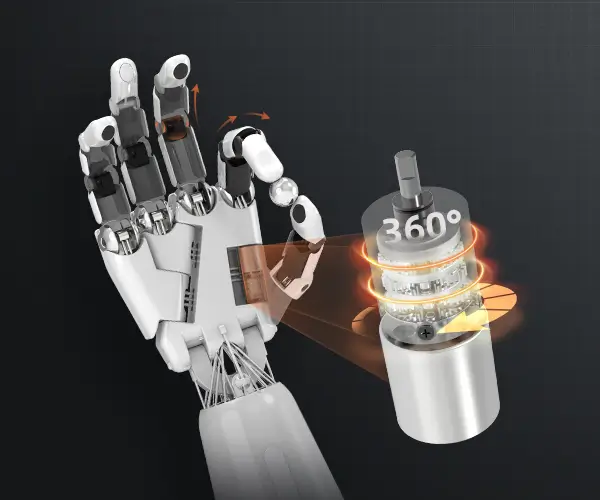Unlocking the Power of Arduino and Servo Motors: An Introduction
Imagine a world where your creations move seamlessly, creating motion that’s not only precise but also adaptable—a world where you can bring robots, art installations, or even automated home projects to life, all with the simple yet powerful combination of Arduino and servo motors. Whether you’re a beginner eager to explore electronics or a seasoned maker looking to expand your toolkit, understanding how to control a servo motor with Arduino opens up a universe of possibilities.

What Is a Servo Motor? At its core, a servo motor is a compact, precise actuator designed to rotate to a specific position within its range, typically from 0 to 180 degrees. Unlike standard motors that spin continuously, servos have an integrated control circuit and feedback mechanism—allowing for exact positioning and repeatability. This makes them invaluable for applications requiring precise control, such as robotic arms, camera gimbals, or even remote-controlled vehicles.
Why Use Arduino for Servo Control? Arduino boards, renowned for their versatility and user-friendly programming environment, serve as ideal controllers for servo motors. They make the process accessible; with just a few lines of code, you can command your servo to move in exact increments, respond to sensor inputs, or even perform complex sequences. Their widespread community support also means abundant resources, tutorials, and troubleshooting tips to get you started.
Getting Started with Basic Components To embark on your servo control journey, you’ll need minimal components:
An Arduino board (e.g., Uno, Nano, Mega) A servo motor (commonly SG90 or MG996R for hobby projects) Jumper wires A power supply suitable for your servo (generally, the Arduino’s 5V pin suffices for small servos, but larger ones might require external power) Optional: Breadboard for easier connections
The Fundamental Concept—Pulse Width Modulation (PWM) Serial communication with servos relies on PWM signals—digital pulses that vary in width to encode positional commands. Typically, a pulse every 20 milliseconds indicates the servo's position: a wider or narrower pulse corresponds to different angles. For instance, a 1 millisecond pulse might mean 0°, while a 2 millisecond pulse means 180°, with intermediate widths for intermediate positions.
Connecting the Hardware Set up your hardware with straightforward wiring:
Connect the servo's power line (often red) to the Arduino’s 5V Connect the ground line (black or brown) to GND Connect the control signal line (usually yellow or orange) to one of Arduino's PWM digital pins, like pin 9
This basic setup forms the foundation for your control program. Once assembled, you're ready to upload your first code.
Programming Your Arduino: Step-by-Step Servo Control
Now that your hardware is connected, it’s time to write the code that tells your servo what to do. Arduino's programming environment simplifies this process, and by the end of this segment, you'll be able to make your servo sweep back and forth or respond to user input—all with just a few lines of code.
Including the Servo Library Arduino provides a built-in servo library that streamlines controlling servo motors:
#include
This pre-written code handles the complex PWM signals internally, allowing you to focus on the movement logic.
Creating a Servo Object Within your setup, instantiate a Servo object:
Servo myServo;
Assign it to the pin you're using:
void setup() { myServo.attach(9); // Pin 9 }
Simple Sweep Script A great starting point is making your servo sweep from 0° to 180° and back:
void loop() { for (int pos = 0; pos <= 180; pos += 1) { myServo.write(pos); delay(15); // Wait for the servo to reach the position } for (int pos = 180; pos >= 0; pos -= 1) { myServo.write(pos); delay(15); } }
This code gradually moves the servo from one end to the other, creating a smooth oscillation. Feel free to tweak the delay for faster or slower movements.
Advanced Control: Responding to Inputs Adding sensors or user inputs makes your project interactive. For example, using a potentiometer to control servo position:
int potPin = A0; // Potentiometer connected to analog pin A0 void setup() { myServo.attach(9); Serial.begin(9600); } void loop() { int val = analogRead(potPin); int angle = map(val, 0, 1023, 0, 180); // Map sensor reading to angle myServo.write(angle); Serial.println(angle); delay(15); }
This code reads the potentiometer’s position and translates it into servo movement, offering real-time control.
Troubleshooting Common Issues
Servo jittering or not moving: Check connections, ensure power supply is adequate, and verify the signal pin matches your code. Servo stalling at certain positions: It might be a code issue or physical obstruction; testing with a simple sweep can help isolate the problem. Unintended resets or erratic behavior: Ensure your power supply is stable, especially if using multiple servos or larger models.
Best Practices and Tips
Use a dedicated power source for multiple servos to prevent voltage drops. Avoid commanding your servo to move rapidly back and forth—irregular movements can stress the servo. Calibrate your servo if it doesn’t seem to reach the exact angles, as some cheap servos have slight variances.
Exploring Further: Making Your Project Smarter
Once comfortable with basic control, explore expanding your project:
Add sensors (ultrasound, IR) for obstacle avoidance Incorporate Bluetooth modules for remote control Integrate with LEDs, motors, or cameras for multi-component projects
Getting lost in creative thought is part of the process. Each servo controlled with Arduino becomes a stepping stone toward more elaborate and capable systems. Whether you’re building a robotic arm, animating art, or automating a device, understanding how to command your servo effortlessly transforms your ideas into reality.
Established in 2005, Kpower has been dedicated to a professional compact motion unit manufacturer, headquartered in Dongguan, Guangdong Province, China.




































